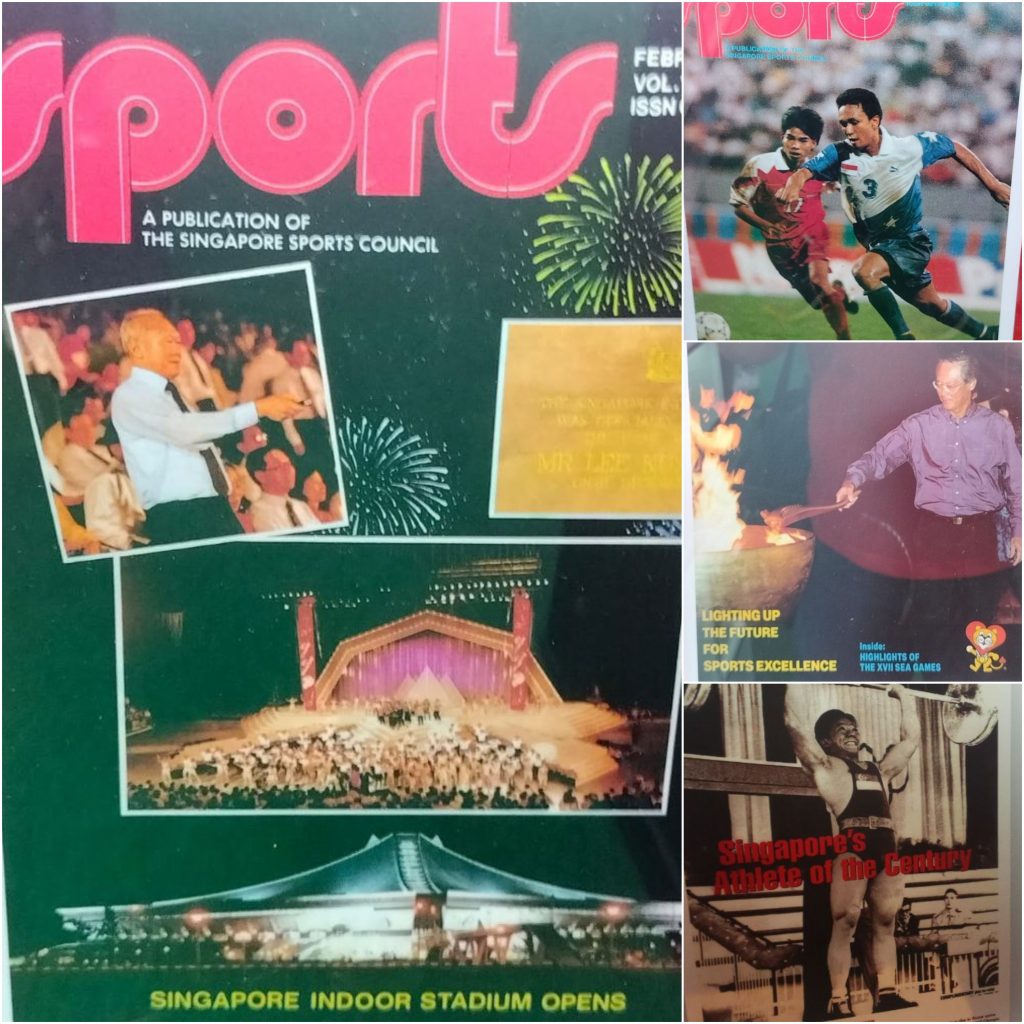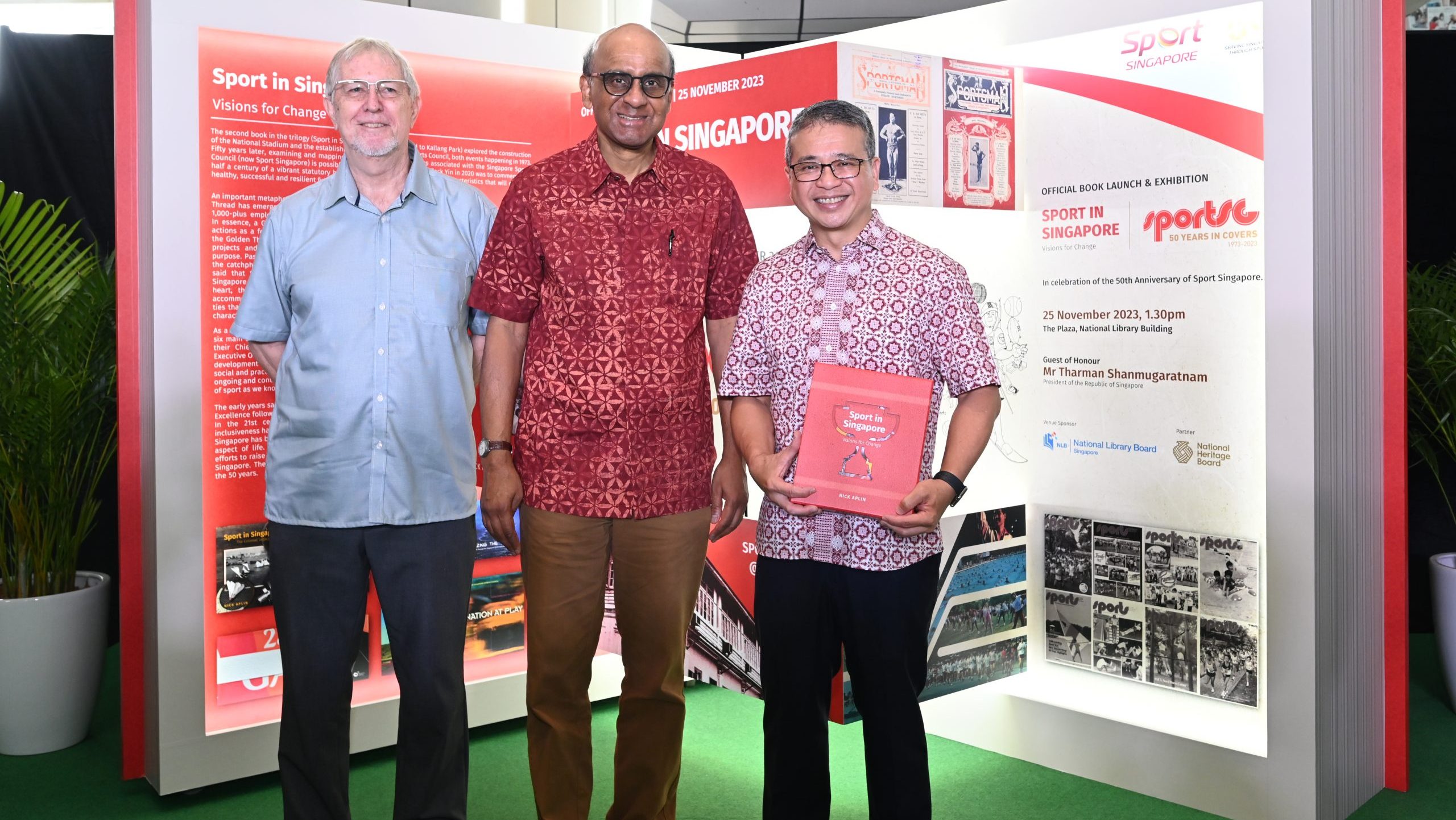SINGAPORE: During the launch of “Sport in Singapore: Visions for Change”, the concluding book in a three-part series by historian Dr Nick Aplin, held on Saturday, Nov 25, President Mr Tharman Shanmugaratnam highlighted two valuable lessons that everyone can learn from Singapore’s sporting legends of the early years: unwavering grit and determination, and the importance of providing an opportunity for multiracialism to bloom in sports.
The event also commemorates Sport Singapore’s 50th anniversary and the opening of a sports heritage exhibition curated by Teresa Teo, Sport Singapore’s sports heritage division’s assistant director. During a guided walkthrough of the exhibition, former champions such as P.C. Suppiah, James Wong and father-son duo Wong Shoon Keat and Derek Wong shared their unique experiences in advancing their chosen sport with the guests. They brought the exhibition panels made up of 320 magazine covers to life.


“As we go forward, there are two lessons we draw from where we were in the early years. We have far better facilities now, far better technical support, far better coordination including getting individuals together across the boundaries of schools,” said President Tharman, who was joined at the event by Edwin Tong, Minister for Culture, Community and Youth and Second Minister for Law, and other senior representatives from Sport Singapore, National Library Board and National Heritage Board.
“The first is about the sheer grit and determination of those exceptional individuals and teams of the early years. The ‘OGs’, as we might call them – the ‘original gangsters’ – with their old-fashioned exceptionalism and sheer grit and determination.”
Despite limited training facilities and resources, past athletes demonstrated remarkable resilience and achieved success on the international stage. President Tharman highlighted several examples, including Chee Swee Lee’s gold medal victory at the 1974 Tehran Asian Games, which Singapore was only able to replicate nearly half a century later when Shanti Pereira clinched the historic 200m gold medal at the Hangzhou Asian Games earlier this year. C. Kunalan’s 100m national record achieved at the 1968 Mexico Olympics stood unbroken for three decades until U.K. Shyam surpassed it in 2001.
“Likewise in football, from Quah Kim Song to Fandi Ahmad, they had something extra. In hockey, from Douglas Nonis to Melanie Martens, and not forgetting Annabelle Pennefather. They all had that X factor, that grit and determination, that I’m sure we have within us and can rekindle. And with today’s far superior infrastructure, coaching, technical support, coordination, spotting of talents, I think we can achieve much higher levels of excellence in the years to come,” added President Tharman.
Multiracialism in Sports
“A second dimension that’s worth reflecting on, and which is an opportunity, is multiracialism in sports. Several of our sports were more multiracial in the earlier days. Football is an example,” mentioned President Tharman in the latter part of his speech during the launch of the book ‘Sport in Singapore: Visions for Change.’
The President said that when Team Singapore athletes compete in overseas competitions, they face opponents of different nationalities and ethnicities; “But in Singapore, we are still too ethnically defined in several of our sports. Some were traditionally like that, but need not be like that in future, and some were previously more multiracial and have become less so now.”
Calling it an ‘opportunity for the future’, President Tharman added that there are benefits in making various sports more multiracial.
“First, so we don’t miss out on potential talents. But there’s another reason for it, which gets us back to the emotions that are evolved in sports. When we plough the multiracial field in sports, we’re also developing a deeper team spirit in Singapore. Sports are one of the ways in which we achieve this,” explained President Tharman.
“We are building on the successes of the old years and of recent years, and we can achieve something special for Singapore through sports. But let’s think about that old fashioned grit and determination – how we rekindle it and allow individuals, and their parents who support them, to sustain it as they grow up. Second, let’s plough the field of multiracialism in sports a lot more, let work more actively to deepen the Singapore spirit through sport.”
Sports Heritage Exhibition


Taking place at The Plaza National Library Building, the event also celebrated 50 years of Singapore’s sporting history and marked the opening of a sports heritage exhibition featuring panel installations.
The sports heritage exhibition pays tribute to significant milestones from the past five decades, such as the country’s first Olympic medal in 1960 and the opening of the National Stadium in 1973. In collaboration with the National Heritage Board, the exhibition also displays two valuable copies of The Sportsman Magazine, reproduced from originals housed in the National Museum of Singapore.
A special feature of the exhibition is the digital and interactive display of The Sportsman magazine, first published in 1930 by Singapore’s first President, Mr Yusof Ishak and his two friends Ong Chin Beng and Soh Swee Tuck. A scholar, sportsman and journalist, Mr Yusof provided readers in the 1930s with a captivating view of the sporting culture in the Straits. After three years, Mr Yusof relinquished his publishing role, but the magazine continued its run for ten years.
The exhibition will be held from 25 Nov 2023 to 10 January 2024 at The Plaza, National Library Building, and is open to all members of the public.

